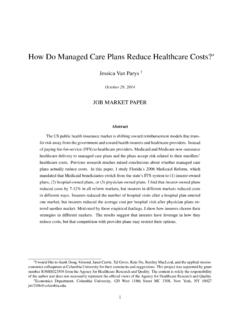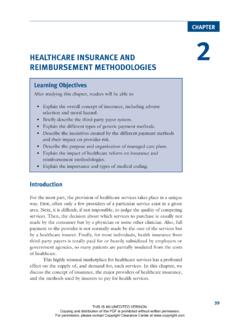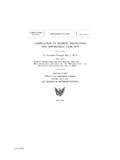Transcription of Change Management in Healthcare - Lit Review - …
1 Change Management in Healthcare Literature Review Michael Antwi Mruganka Kale January 2014. Change Management in Healthcare Literature Review Table of Contents Introduction .. 1 Research 1 Background The Current State of Canadian Healthcare .. 1 Change Management Models .. 3 Planned Change and Emergent Change .. 3 Models Driving Change .. 4 Planned Change Models .. 4 Field Theory .. 4 Group Dynamics .. 5 Action Research .. 5 3-Step Model .. 5 Emergent Change Models .. 7 Hinings and Greenwood's Model of Change Dynamics .. 7 Kanter et al.'s Big Three Model of Organizational Change .. 8 Pettigrew's Context/Content/Process Model .. 9 Change Management Models in Health Research .. 10 Lukas et al.'s Organizational Model for Transformational Change in Healthcare Systems 10 Canadian Health Services Research Foundation (CHSRF)'s Evidence-Informed Change Management Approach.
2 11 Canada Health Infoway Change Management Framework .. 12 Comparing Canada Health Infoway Change Management Framework against Established 13 National Health Service Change Management Guidelines .. 15 Institute for Healthcare Improvement's Triple Aim Framework .. 16 Core Elements of Change 18 Mapping Healthcare Organizational Change Management Models against Core Elements of Theoretical Models .. 20 Change Management Models in Healthcare Research .. 23 Applying Change Management Processes to Canadian Healthcare .. 24 Preparing for Change .. 24 Implementing Change .. 26 Sustaining Change .. 27 Opportunities for Future Research .. 28 References .. 30 Change Management in Healthcare Literature Review Introduction Research Methodology This literature Review provides an overview of existing research on Change Management in Healthcare to support the identification of key research priorities for effecting Change in Canadian Healthcare .
3 It was prepared to support the Monieson Centre for Business Research in Healthcare 's Change Management for Healthcare Policy Workshop through funding from a Canadian Institutes of Health Research Planning Grant. The goal of the workshop is to enable interaction between Queen's School of Business researchers with expertise in existing Change Management theory, Healthcare policy researchers from Queen's Faculty of Health Sciences and School of Policy Studies possessing knowledge of the challenges facing the Healthcare system, and key sector stakeholders, in order to develop a vision for partner-oriented research on Healthcare policy reform . The research design consisted of a systematic Review of the literature in both Healthcare and business contexts of Change Management . Inclusion criteria parameters for the literature search included years 1990 to 2013 from Canada, the United States and international English-language studies.
4 Search terms included Change Management Healthcare , managing Change health, Change Management models in Healthcare , and Healthcare Change Canada. Databases used for searches included ABI/Inform, Business Source Complete, Canadian Electronic Library, CBCA, PubMed, Scholars Portal, Science Direct, and Scopus. The researchers reviewed over 100 scholarly articles, which included publications from the grey literature, and these were further narrowed down to 45 articles that fit the necessary criteria. Background The Current State of Canadian Healthcare Canada's Healthcare system is in need of significant Change . Where 2011 Healthcare spending was originally forecast to reach of GDP [2], it ultimately grew to approximately $193 billion, or of GDP [1]. A 2010 comparison of 11 countries ranked Canada lowest in several key wait times: being able to see a doctor or nurse when sick, seeing a specialist, and having elective surgery [1, 2].
5 Among these comparators, Canada had the largest proportion of adults waiting in emergency departments for four hours or more before receiving treatment. Furthermore, for specialist appointments, 41% of Canadian patients reported wait times of over two months, which was 7 percentage points greater than the second-lowest ranked country, Norway. With Canada ranking last out of 30 countries in terms of value for money [3], efficiencies in the Management of Canada's Healthcare systems must be found. The added complexity of an aging population only increases the need for effective primary care reform , improved chronic disease Management , better integrated care models of care delivery, and contained costs of Healthcare delivery. The need for reform has been clearly identified by Canadians at both patient and Healthcare professional levels.
6 The highest priority for Canadians is timely access to care followed by high quality of care, both of which are believed to have declined in recent years [3]. Ten years ago, the 2003 First Ministers' Accord on Health Care Renewal and the 2004 10-Year Plan to Strengthen Health Care were created in order to stimulate a decade of reform , but successes have been limited. Innovations in Healthcare delivery did not reach their full potential, in part due to difficulties in finding effective ways to share knowledge and integrate best practices among jurisdictions. Canada's Healthcare system is highly valued by its citizens. However, the health system has been unable to keep pace with the evolving needs of Canadians. As such, many decision makers believe the Canadian Healthcare system needs to be massively transformed [3].
7 1. Change Management in Healthcare Literature Review Healthcare organizations are complex, in part because of a confluence of professions, including physicians, nurses, pharmacists, and administrators, each with seemingly competing interests, perspectives, and time horizons. Addressing these myriad issues affecting Canada's Healthcare system will require ongoing leadership from governments and provider organizations, and stronger collaboration amongst Healthcare professionals. It is important that all of these stakeholders have a common understanding of Change and its implications. Proposals to reform the Canadian Healthcare system will only be successful if existing institutional legacies and the interests of leaders and stakeholder groups are taken into account. Pouring more money into a system that isn't configured to achieve desired societal outcomes is an ineffective way to allocate resources.
8 Instead, practical solutions must be implemented to deliver improved health and economic outcomes. There is a pressing need to provide Canadian Healthcare decision makers, professionals, and researchers with a well-defined and relevant set of interdisciplinary and evidence-informed approaches to Change that can be applied in a variety of contexts. Managing organizational culture is increasingly viewed as an essential part of health system reform . Change Management theory offers solutions for the effective implementation of Healthcare reforms. To facilitate Healthcare reform in Canada, health managers and other decision makers must have an understanding of how Change occurs in order to create a setting that is conducive to innovation. Individuals experience Change in two distinct ways, either as Change agents or Change targets [4].
9 Change agents are individuals entrusted with the duty and concomitant powers necessary to effect Change in policy or practice [5]. These individuals may include policy makers, managers within an organization, and Management consultants. Change targets refers to those being reorganized within an organization as part of the Change process. These individuals typically include employees within an organization; however, individuals may also be agents and targets of Change simultaneously [4]. Cultivating an environment conducive to Change entails gaining commitment and overcoming resistance. This can be accomplished by understanding the motives of those affected by the Change and determining whether they view the Change positively or negatively. In order to secure commitment to Change , an individual must perceive the positive factors associated with Change as outweighing the negative [4].
10 In the context of Canadian Healthcare , building commitment entails gaining the support of the entire system, from patients to doctors, to front-line nurses and hospital administrators, to personal support workers and governmental officials. The presence of strong leadership and the ability to establish new forms of cooperation will play an important role in cultural transformation. Change must be undertaken with the patients' interests at the centre. Resistance to Change arises out of a plethora of factors that make addressing the issue very complex. Managers must skilfully adopt an optimal strategy using a combination of approaches best suited for the situation and individuals involved. Managers can classify these individuals based on their level of resistance, and determine the level of consultation and overall engagement they will need in order to mitigate resistance [4].











